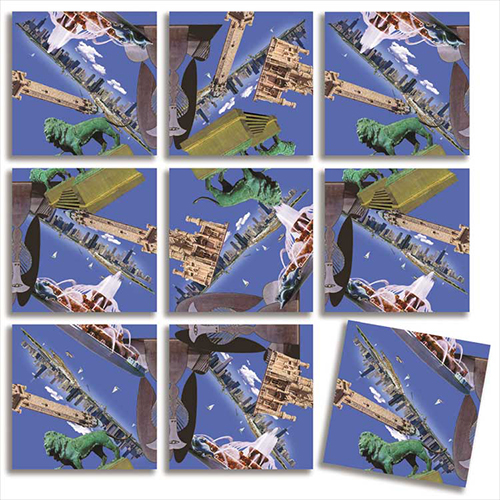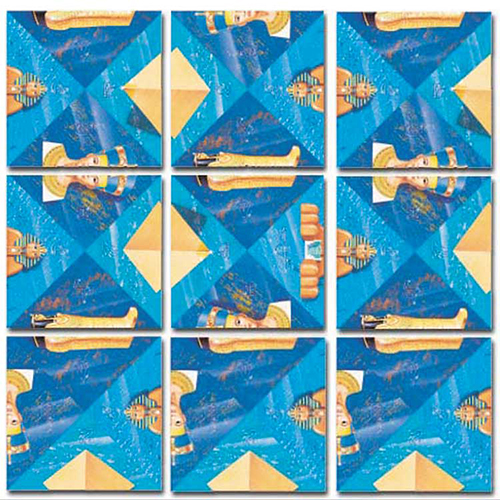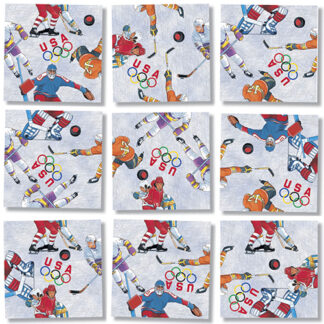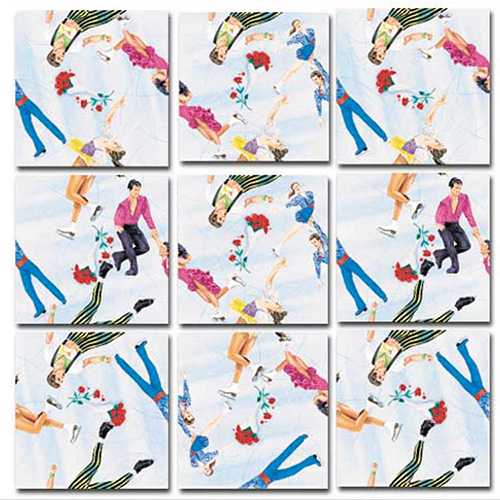Description
The ‘City of the Big Shoulders’ with its sunny disposition and ‘Will do!’ spirit is a Scramble Squares® puzzle that will challenge even the most accomplished puzzle fanatic.
Fascinating Facts
The now elegant and majestic Chicago lakefront was called “Checagou,” literally “place of the bad smell,” by its Pottawatomie Native American inhabitants when, in 1673, French explorers Pére Jacques Marquette and Louis Jolliet discovered that the French fur trade could reach America’s fertile heartland from the Great Lakes by portaging from the Chicago River to the DesPlaines River, linking with the Illinois River, which fed into the Mississippi. Checagou was then a shoreline of mosquito infested sand dunes and swamps where the “chicakagou” wild onions flourished and the lake’s breezes circulated their unpleasant smell. Chicago’s first settler was Jean Baptiste DuSable, a fugitive slave from San Domingo, who established a trading post on the north bank of the Chicago River. The city was incorporated in 1837 with a population of 4,170. In only sixty years, from 1830 to 1890, the population of the area grew from about 100 fur traders and Native Americans to an amazing 1 million people, a growth that was faster than any other city in recorded history! The Chicago River at Lake Michigan became the busiest port in the United States, crowded with ships that carried grain, lumber, meat and many other commodities and finished goods to and from nearby railroads that provided commerce to the nation.
Chicago’s reputation as a world laboratory for architecture was fueled by fire. By the 1850s, the banks of the Chicago River were lined with wooden wharves. Fresh cut lumber stacked on the docks and rows of grain elevators became Chicago’s first skyline. “Balloon-frame” buildings, hastily made with 2 x 4’s enabled the port town to grow like wildfire, but also served as an abundant combustible fuel for the Great Chicago Fire of 1871, which destroyed 17,450 buildings and left 100,00 people homeless. The fire’s heat was so intense that coins fused together and a hardware store was reduced into a large ball of melted iron, preserved to this day by the Chicago Historical Society. Catherine O’Leary was an Irish immigrant living on DeKoven Street on the city’s southwest side. No one knows whether Mrs. O’Leary’s cow really kicked over a lantern into a pile of hay, but on the evening of October 8, 1871 a small fire did begin in her barn and began to spread until it became a conflagration that was worse than the London fire of 1666. The fire jumped the river and destroyed everything in its path to the north until rain finally began to dowse the flames 25 hours later. Ironically, Mrs. O’Leary’s house and the Chicago Water Tower, which stands proudly to this day on “The Magnificent Mile” of North Michigan Avenue, were among the very few structures not destroyed by the fire. Chicago’s determined population, with its indomitable “I Will” spirit and available natural resources, turned the destruction of the city into an opportunity to rebuild from the ground up a bigger and better uniquely American city, beginning one of history’s most important periods of architectural development.
Architects came to Chicago to join the builders to make their mark on the empty canvas which had held the image of a thriving city. William Le Baron Jenney, Louis Sullivan, Daniel Burnham, John Root, Dankmar Adler and, later, Frank Lloyd Wright and Ludwig Mies van der Rohe created architectural masterpieces like the metal framed Home Insurance building, in 1885, the world’s first “skyscraper,” the Rookery, the Auditorium, the Marquette Building and the Monodnak Building. The pride that Chicagoans felt for their “toddlin’” town’s accomplishments quickly bellowed into its “Windy City” nickname, originating not from Chicago’s chilling Lake Michigan winds, but from its self-promoting hyperbole during Chicago’s competition with New York to host the 1893 World’s Fair. New York Sun editorialist Charles A. Dana, campaigning against Chicago, responded to Chicago’s bravado by writing that the Fair’s sponsors should not listen “to the nonsensical claims of that windy city.” Chicago won the competition, and under the guidance of Chicagoan Daniel Hudson Burnham, whose motto was, “Make no little plans, for they have no magic to stir men’s blood,” erected enormous gleaming white Classical Greek style stucco buildings in Jackson Park as the venues for the “World’s Columbian Exposition of 1893.” On the Fair’s Midway Plaisance, intrepid thrill seekers rode high above the city on a monumental Ferris Wheel, which has now been recreated on a much smaller scale on Navy Pier.
In 1900 the Army Corps of Engineers dug the Sanitary and Ship Canal that connected the Chicago and Illinois rivers, accomplishing the amazing engineering feat of reversing the flow of the Chicago River so that it carried the pollution of urban sewage away from Lake Michigan, the source of Chicago’s water supply. In 1909, Burnham and his assistant Edward H. Bennett wrote “The Plan for Chicago,” the nation’s first comprehensive city planning document. A unique feature of that plan, is the permanent conservation of the entire Chicago lakefront for recreational use in the natural surroundings of parks, lagoons and small harbors, including Lincoln Park Zoo, the nations’ only big city free zoo. The conservation of nature along the length of Chicago’s lakefront remains today the emerald and gold necklace that adorns the beauty of the proud and powerful city that Carl Sandburg described in his 1916 poem Chicago as the “City of the Big Shoulders ” and promts millions to proclaim, “It’s my kind of town!”





Reviews
There are no reviews yet.